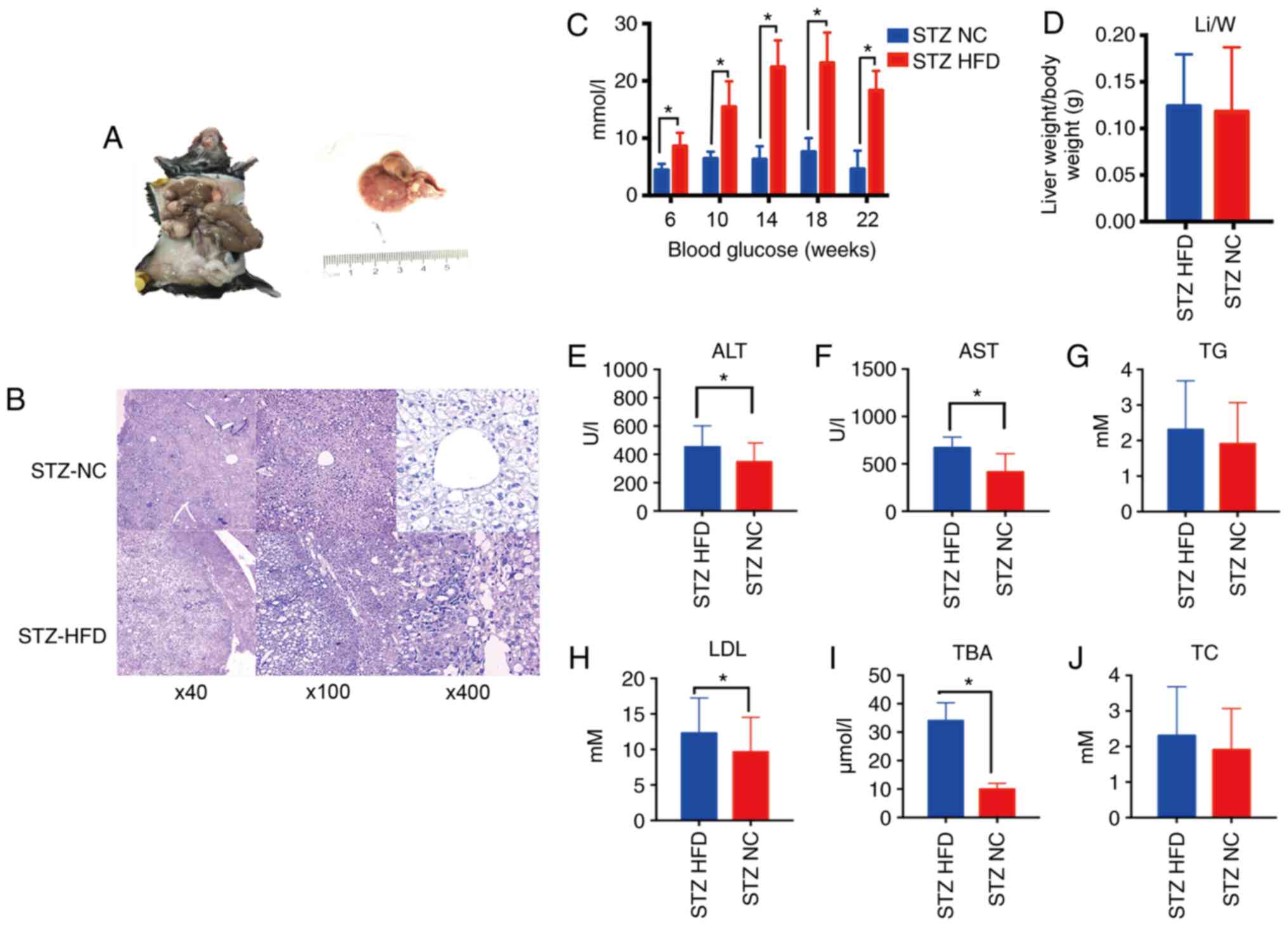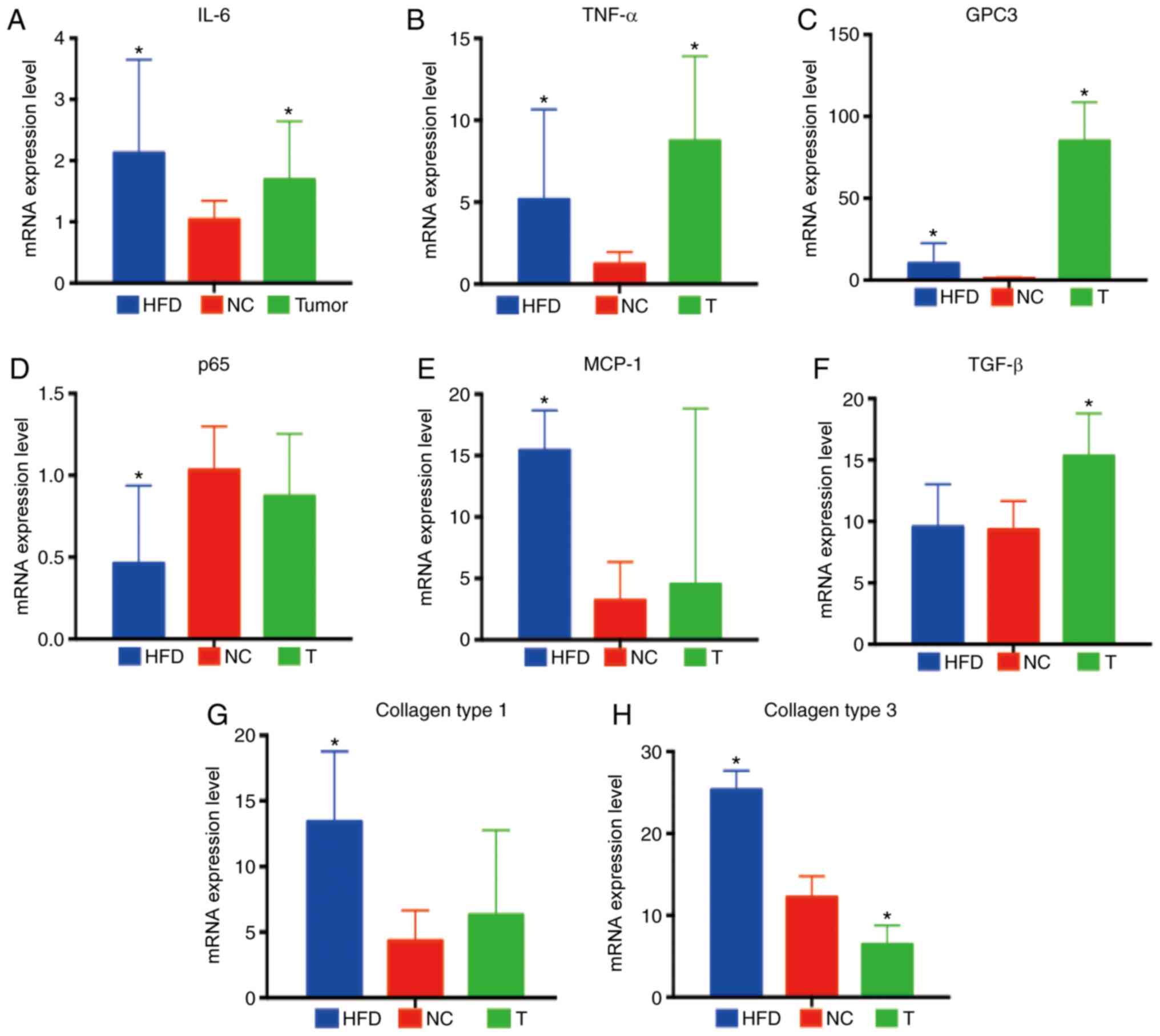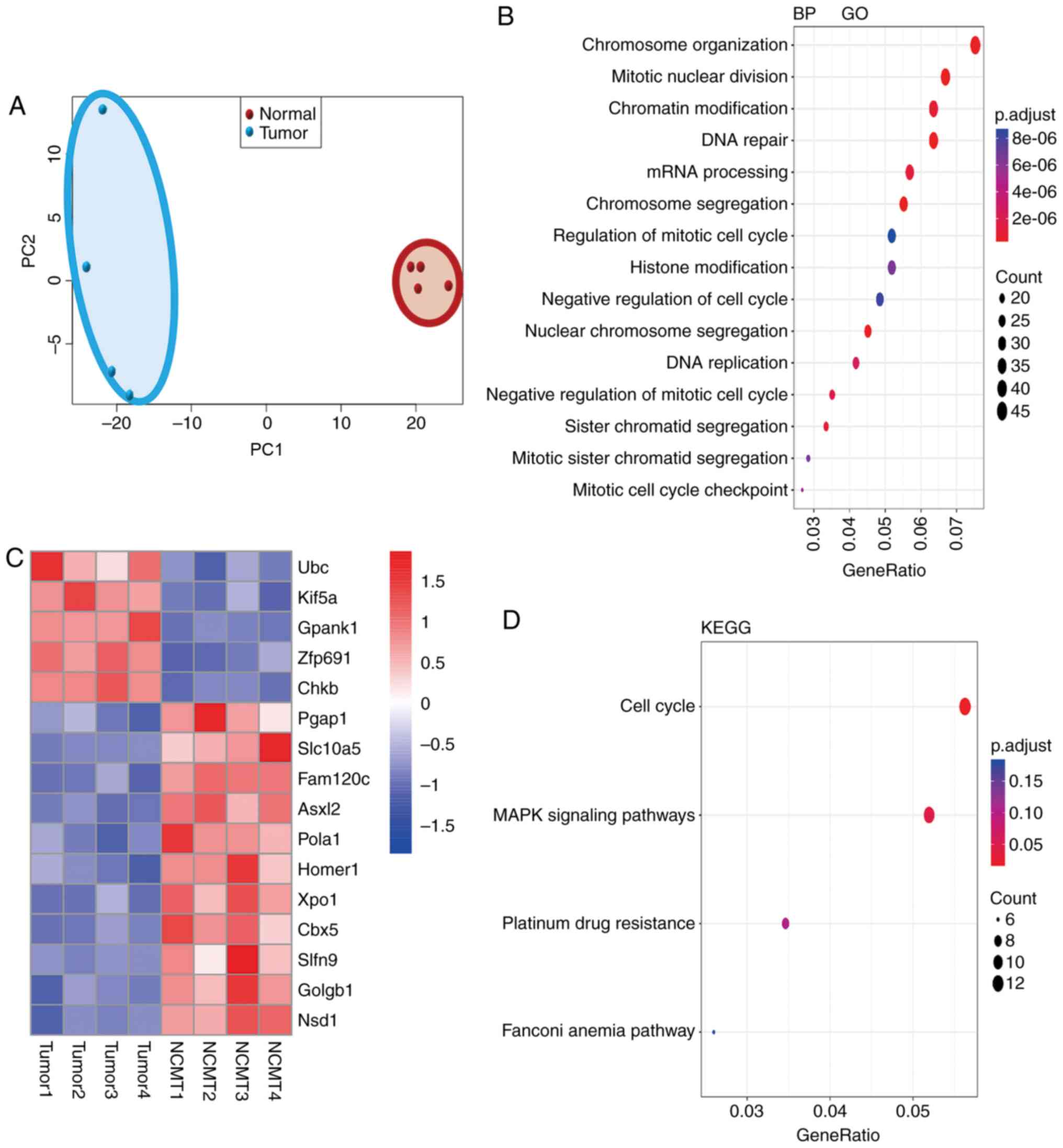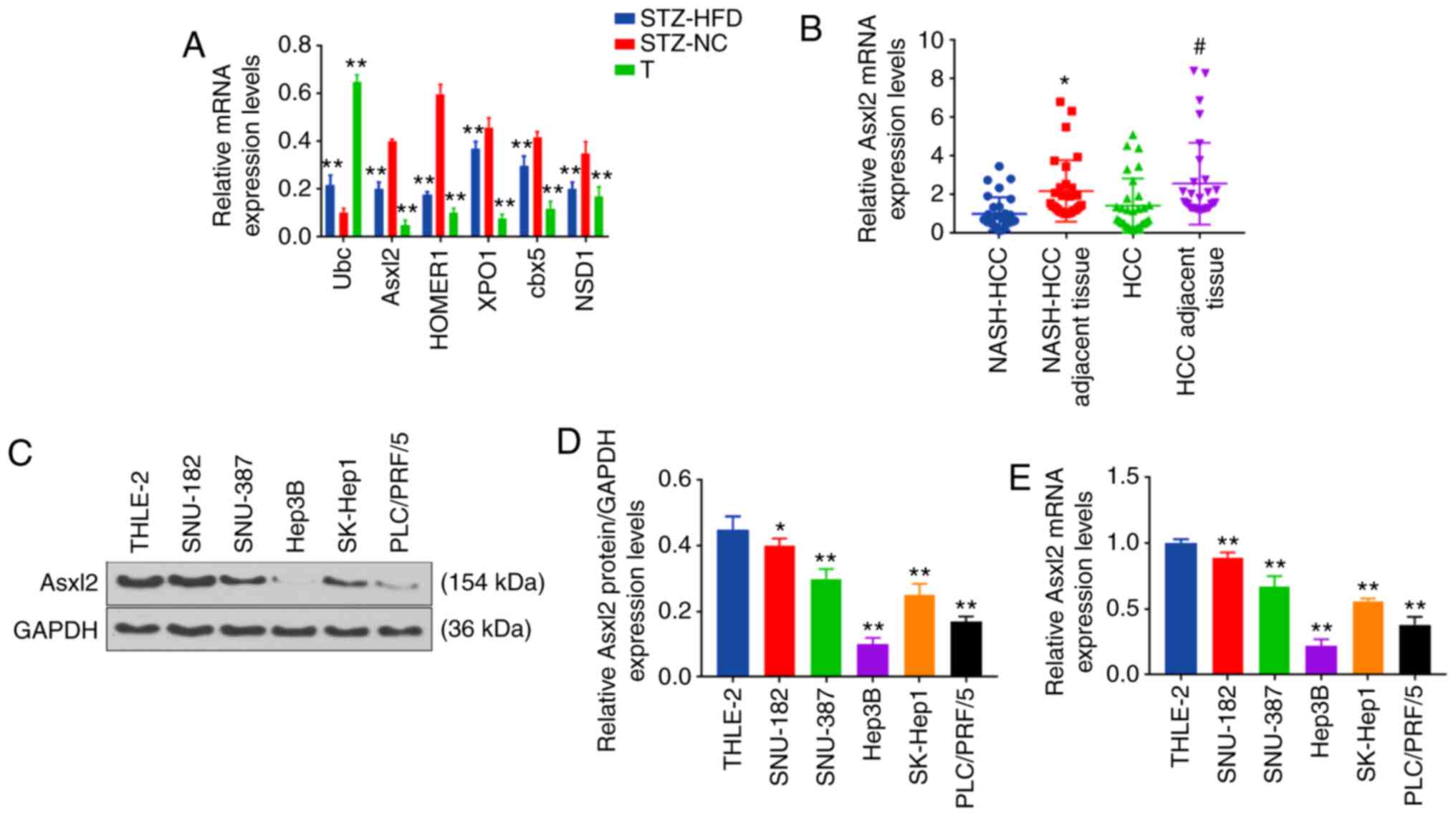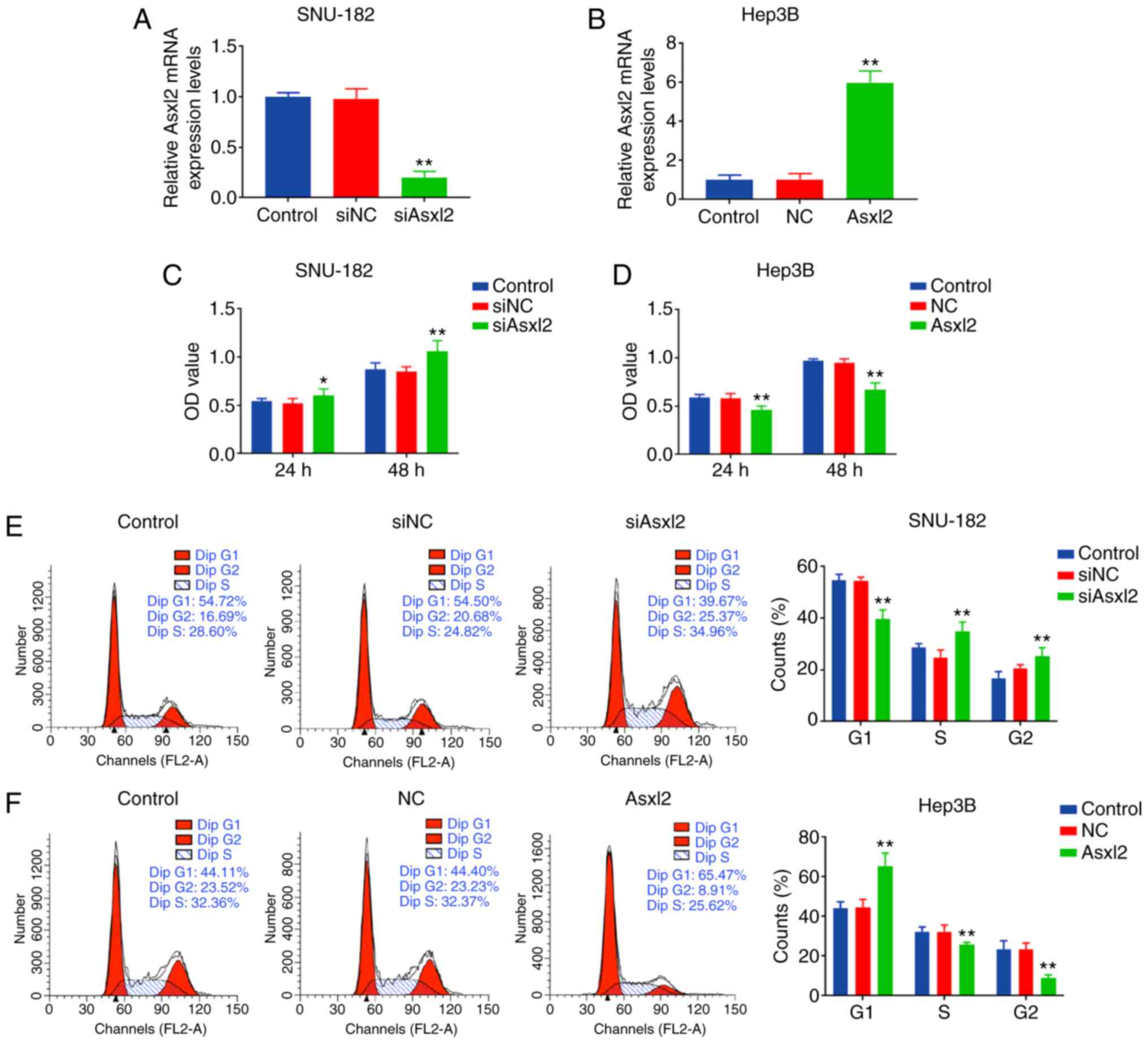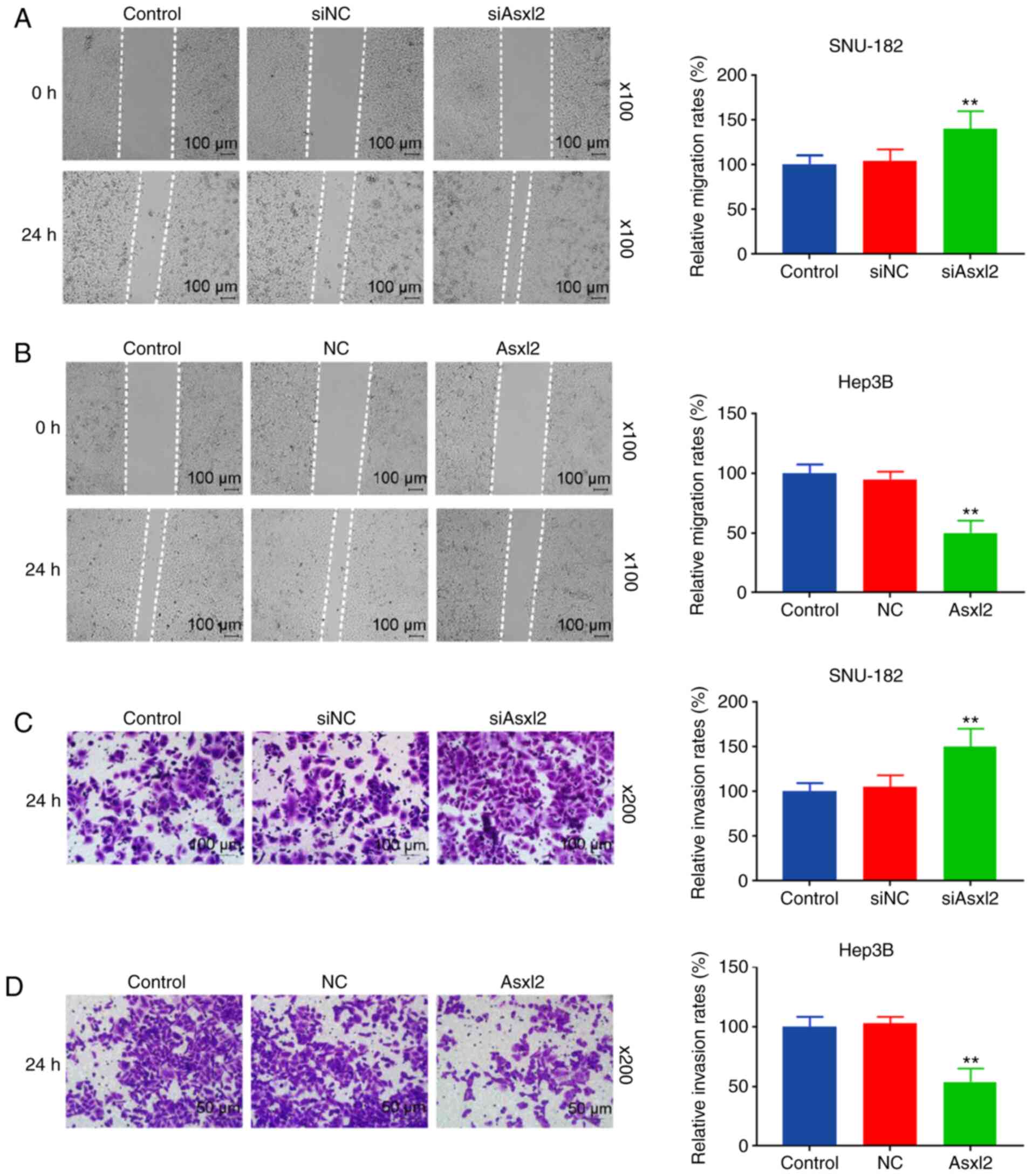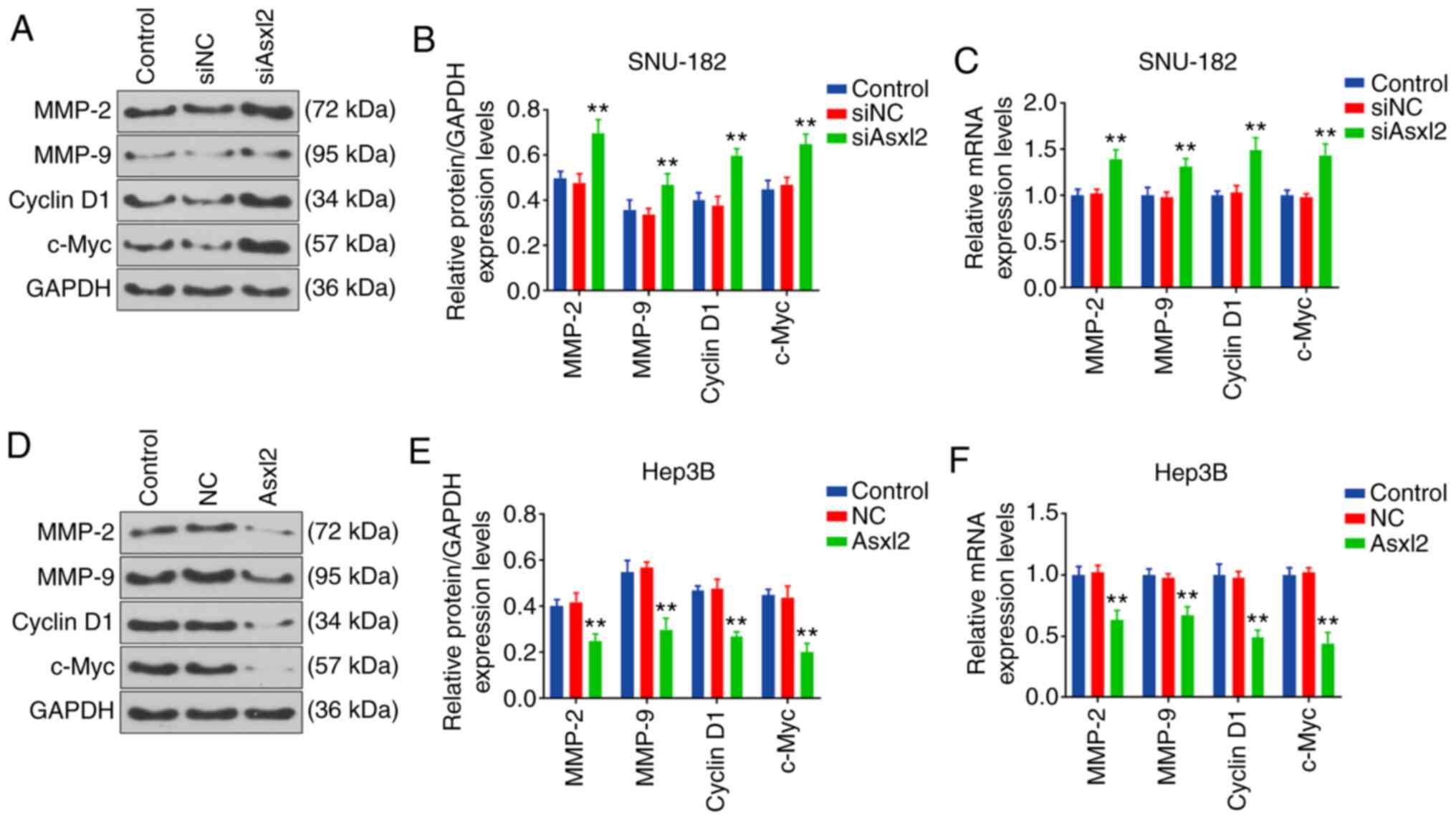|
1
|
Shariff MI, Cox IJ, Gomaa AI, Khan SA,
Gedroyc W and Taylor-Robinson SD: Hepatocellular carcinoma: Current
trends in worldwide epidemiology, risk factors, diagnosis and
therapeutics. Exp Rev Gastroenterol Hepatol. 3:353–367. 2009.
View Article : Google Scholar
|
|
2
|
Yu Y, Cai J, She Z and Li H: Insights into
the epidemiology, pathogenesis, and therapeutics of nonalcoholic
fatty liver diseases. Adv Sci (Weinch). 6:18015852019. View Article : Google Scholar
|
|
3
|
Xie G, Wang X, Huang F, Zhao A, Chen W,
Yan J, Zhang Y, Lei S, Ge K, Zheng X, et al: Dysregulated hepatic
bile acids collaboratively promote liver carcinogenesis. Int J
Cancer. 139:1764–1775. 2016. View Article : Google Scholar : PubMed/NCBI
|
|
4
|
Anstee QM, Reeves HL, Kotsiliti E, Govaere
O and Heikenwalder M: Gastroenterology HMJNr and hepatology: From
NASH to HCC: Current concepts and future challenges. Nat Rev
Gastroenterol Hepatol. 16:411–428. 2019. View Article : Google Scholar : PubMed/NCBI
|
|
5
|
van der Meer AJ, Feld JJ, Hofer H, Almasio
PL, Calvaruso V, Fernández-Rodríguez CM, Aleman S, Ganne-Carrié N,
D'Ambrosio R, Pol S, et al: Risk of cirrhosis-related complications
in patients with advanced fibrosis following hepatitis C virus
eradication. J Heptol. 66:485–493. 2017. View Article : Google Scholar
|
|
6
|
Noureddin M and Rinella ME: Nonalcoholic
fatty liver disease, diabetes, obesity, and hepatocellular
carcinoma. Clin Cancer Dis. 19:361–379. 2015.
|
|
7
|
Simon TG, King LY, Chong DQ, Nguyen LH, Ma
Y, VoPham T, Giovannucci EL, Fuchs CS, Meyerhardt JA, Corey KE, et
al: Diabetes, metabolic comorbidities, and risk of hepatocellular
carcinoma: Results from two prospective cohort studies. Hepatology.
67:1797–1806. 2018. View Article : Google Scholar :
|
|
8
|
El-Serag HB, Kanwal F, Richardson P and
Kramer J: Risk of hepatocellular carcinoma after sustained
virological response in Veterans with hepatitis C virus infection.
Hepatology. 64:130–137. 2016. View Article : Google Scholar : PubMed/NCBI
|
|
9
|
El-Shamy A, Eng FJ, Doyle EH, Klepper AL,
Sun X, Sangiovanni A, Iavarone M, Colombo M, Schwartz RE, Hoshida Y
and Branch AD: A cell culture system for distinguishing hepatitis C
viruses with and without liver cancer-related mutations in the
viral core gene. J Hepatol. 63:1323–1333. 2015. View Article : Google Scholar : PubMed/NCBI
|
|
10
|
Setiawan VW, Hernandez BY, Lu SC, Stram
DO, Wilkens LR, Marchand LL and Henderson BE: Diabetes and
racial/ethnic differences in hepatocellular carcinoma risk: The
multiethnic cohort. J Natl Cancer Inst. 106:dju3262014. View Article : Google Scholar : PubMed/NCBI
|
|
11
|
Zhang Q, Deng YL, Liu C, Huang LH, Shang
L, Chen XG, Wang LT, Du JZ, Wang Y, Wang PX, et al: Diabetes
mellitus may affect the long-term survival of hepatitis B
virus-related hepatocellular carcinoma patients after liver
transplantation. World J Gastroenterol. 22:9571–9585. 2016.
View Article : Google Scholar : PubMed/NCBI
|
|
12
|
Chiang CH, Lee LT, Hung SH, Lin WY, Hung
HF, Yang WS, Sung PK and Huang KC: Opposite association between
diabetes, dyslipidemia, and hepatocellular carcinoma mortality in
the middle-aged and elderly. Hepatology. 59:2207–2215. 2014.
View Article : Google Scholar : PubMed/NCBI
|
|
13
|
Shima T, Uto H, Ueki K, Kohgo Y, Yasui K,
Nakamura N, Nakatou T, Takamura T, Kawata S and Notsumata K:
Hepatocellular carcinoma as a leading cause of cancer-related
deaths in Japanese type 2 diabetes mellitus patients. J
Gastroenterol. 54:64–77. 2019. View Article : Google Scholar
|
|
14
|
de Oliveira S, Houseright RA, Graves AL,
Golenberg N, Korte BG, Miskolci V and Huttenlocher A: Metformin
modulates innate immune-mediated inflammation and early progression
of NAFLD-associated hepatocellular carcinoma in zebrafish. J
Hepatol. 70:710–721. 2019. View Article : Google Scholar
|
|
15
|
Ye J, Li TS, Xu G, Zhao YM, Zhang NP, Fan
J and Wu J: JCAD promotes progression of nonalcoholic
steatohepatitis to liver cancer by inhibiting LATS2 kinase
activity. Cancer Res. 77:5287–5300. 2017. View Article : Google Scholar : PubMed/NCBI
|
|
16
|
Vandekerckhove L, Vermeulen Z, Liu ZZ,
Boimvaser S, Patzak A, Segers VF and De Keulenaer GW: Neuregulin-1
attenuates development of nephropathy in a type 1 diabetes mouse
model with high cardiovascular risk. Am J Physiol Endocrinol Metab.
310:E495–E504. 2016. View Article : Google Scholar : PubMed/NCBI
|
|
17
|
Li M, Dou L, Jiao J, Lu Y, Guo HB, Man Y,
Wang S and Li J: NADPH oxidase 2-derived reactive oxygen species
are involved in dysfunction and apoptosis of pancreatic β-cells
induced by low density lipoprotein. Cell Physiol Biochem.
30:439–449. 2012. View Article : Google Scholar
|
|
18
|
Al-Malki AL, Sayed AA and Rabey HA:
Proanthocyanidin attenuation of oxidative stress and NF-κB protects
apolipoprotein E-deficient mice against diabetic nephropathy. Evid
Based Complement Alternat Med. 2013:7694092013. View Article : Google Scholar
|
|
19
|
Livak KJ and Schmittgen TD: Analysis of
relative gene expression data using real-time quantitative PCR and
the 2(-Delta Delta C(T)) method. Methods. 25:402–408. 2001.
View Article : Google Scholar
|
|
20
|
Liao Y, Smyth GK and Shi W: FeatureCounts:
An efficient general purpose program for assigning sequence reads
to genomic features. Bioinformatics. 30:923–930. 2014. View Article : Google Scholar
|
|
21
|
Robinson MD, McCarthy DJ and Smyth GK:
EdgeR: A Bioconductor package for differential expression analysis
of digital gene expression data. Bioinformatics. 26:139–140. 2010.
View Article : Google Scholar
|
|
22
|
Hughes FM, Kennis JG, Youssef MN, Lowe DW,
Shaner BE and Purves JT: The NACHT, LRR and PYD domains-containing
protein 3 (NLRP3) inflammasome mediates inflammation and voiding
dysfunction in a lipopolysaccharide-induced rat model of cystitis.
J Clin Cell Immunol. 7:3962016. View Article : Google Scholar : PubMed/NCBI
|
|
23
|
Wu J, Mao X, Cai T, Luo J and Wei L: KOBAS
server: A web-based platform for automated annotation and pathway
identification. Nucleic Acids Res. 34:W720–W724. 2006. View Article : Google Scholar : PubMed/NCBI
|
|
24
|
Li J, He F, Zhang P, Chen S, Shi H, Sun Y,
Guo Y, Yang H, Man N, Greenblatt S, et al: Loss of asxl2 leads to
myeloid malignancies in mice. Nat Commun. 8:154562017. View Article : Google Scholar : PubMed/NCBI
|
|
25
|
Izawa T, Rohatgi N, Fukunaga T, Wang QT,
Silva MJ, Gardner MJ, McDaniel ML, Abumrad NA, Semenkovich CF,
Teitelbaum SL and Zou W: ASXL2 regulates glucose, lipid, and
skeletal homeostasis. Cell Rep. 11:1625–1637. 2015. View Article : Google Scholar : PubMed/NCBI
|
|
26
|
Hanssen NM, Brouwers O, Gijbels MJ,
Wouters K, Wijnands E, Cleutjens JP, De Mey JG, Miyata T, Biessen
EA, Stehouwer CD and Schalkwijk CG: Glyoxalase 1 overexpression
does not affect atherosclerotic lesion size and severity in
ApoE−/− mice with or without diabetes. Cardiovasc Res.
104:160–170. 2014. View Article : Google Scholar : PubMed/NCBI
|
|
27
|
Huang MC, Chen LY, Chang HM, Liang XY,
Chen CK, Cheng WJ and Xu K: Decreased blood levels of oxytocin in
ketamine-dependent patients during early abstinence. Front
Psychiatry. 9:6332018. View Article : Google Scholar : PubMed/NCBI
|
|
28
|
Huang Z, Jing X, Sheng Y, Zhang J, Hao Z,
Wang Z and Ji L: (-)-Epicatechin attenuates hepatic sinusoidal
obstruction syndrome by inhibiting liver oxidative and inflammatory
injury. Redox Biol. 22:1011172019. View Article : Google Scholar : PubMed/NCBI
|
|
29
|
El-Hawary SS, Ali ZY and Younis IY:
Hepatoprotective potential of standardized ficus species in
intrahepatic cholestasis rat model: Involvement of nuclear
factor-κB, and farnesoid X receptor signaling pathways. J
Ethnopharmacol. 231:262–274. 2019. View Article : Google Scholar
|
|
30
|
Parvez MK, Al-Dosari MS, Arbab AH and
Niyazi S: The in vitro and in vivo anti-hepatotoxic, anti-hepatitis
B virus and hepatic CYP450 modulating potential of cyperus
rotundus. Saudi Pharm J. 27:558–564. 2019. View Article : Google Scholar : PubMed/NCBI
|
|
31
|
Gad-Elkareem MA, Abdelgadir EH, Badawy OM
and Kadri A: Potential antidiabetic effect of ethanolic and
aqueousethanolic extracts of leaves on streptozotocin-induced
diabetes in rats. PeerJ. 7:e64412019. View Article : Google Scholar
|
|
32
|
Kazemi A, Soltani S, Ghorabi S, Keshtkar
A, Daneshzad E, Nasri F and Mazloomi SM: Effect of probiotic and
synbiotic supplementation on inflammatory markers in health and
disease status: A systematic review and meta-analysis of clinical
trials. Clin Nutr. 39:789–819. 2019. View Article : Google Scholar : PubMed/NCBI
|
|
33
|
Azushima K, Uneda K, Wakui H, Ohki K,
Haruhara K, Kobayashi R, Haku S, Kinguchi S, Yamaji T, Minegishi S,
et al: Effects of rikkunshito on renal fibrosis and inflammation in
angiotensin II-infused mice. Sci Rep. 9:62012019. View Article : Google Scholar : PubMed/NCBI
|
|
34
|
Shimizu Y, Suzuki T, Yoshikawa T, Endo I
and Nakatsura T: Next-Generation cancer immunotherapy targeting
glypican-3. Front Oncol. 9:2482019. View Article : Google Scholar : PubMed/NCBI
|
|
35
|
Ortiz MV, Roberts SS, Bender JG, Shukla N
and Wexler LH: Immunotherapeutic targeting of GPC3 in pediatric
solid embryonal tumors. Front Oncol. 9:1082019. View Article : Google Scholar : PubMed/NCBI
|
|
36
|
Cohen JV and Sullivan RJ: Developments in
the space of new MAPK pathway inhibitors for BRAF-mutant melanoma.
Clin Cancer Res. 25:5735–5742. 2019. View Article : Google Scholar : PubMed/NCBI
|
|
37
|
Liu Y, Yang Z, Du F, Yang Q, Hou J, Yan X,
Geng Y, Zhao Y and Wang H: Molecular mechanisms of pathogenesis in
hepatocellular carcinoma revealed by RNA-sequencing. Mol Med Rep.
16:6674–6682. 2017. View Article : Google Scholar : PubMed/NCBI
|
|
38
|
Birnbaum DJ, Finetti P, Birnbaum D,
Mamessier E and Bertucci F: Expression is a poor-prognosis marker
in pancreatic adenocarcinoma. J Clin Med. 8:5962019. View Article : Google Scholar
|
|
39
|
Vad-Nielsen J, Jakobsen KR, Daugaard TF,
Thomsen R, Brügmann A, Sørensen BS and Nielsen AL: Regulatory
dissection of the CBX5 and hnRNPA1 bi-directional promoter in human
breast cancer cells reveals novel transcript variants
differentially associated with HP1α down-regulation in metastatic
cells. BMC Cancer. 16:322016. View Article : Google Scholar
|
|
40
|
Luo P, Feng X, Jing W, Zhu M, Li N, Zhou
H, Worley PF, Chai H and Tu J: Clinical and diagnostic significance
of Homer1 in hepatitis B virus-induced hepatocellular carcinoma. J
Cancer. 9:683–689. 2018. View Article : Google Scholar : PubMed/NCBI
|
|
41
|
Madan V, Han L, Hattori N, Teoh WW,
Mayakonda A, Sun QY, Ding LW, Nordin HB, Lim SL and Shyamsunder P:
ASXL2 regulates hematopoiesis in mice and its deficiency promotes
myeloid expansion. Haematologica. 103:1980–1990. 2018. View Article : Google Scholar : PubMed/NCBI
|
|
42
|
Park UH, Yoon SK, Park T, Kim EJ and Um
SJ: Additional sex comb-like (ASXL) proteins 1 and 2 play opposite
roles in adipogen-esis via reciprocal regulation of peroxisome
proliferator-activated receptor {gamma}. J Biol Chem.
286:1354–1363. 2011. View Article : Google Scholar
|
|
43
|
Hung CY, Lee CH, Chiou HL, Lin CL, Chen
PN, Lin MT, Hsieh YH and Chou MC: Praeruptorin-B inhibits
12-O-tetradecanoylphorbol-13-acetate-induced cell invasion by
targeting AKT/NF-κB via matrix metalloproteinase-2/-9 expression in
human cervical cancer cells. Cell Physiol Biochem. 52:1255–1266.
2019. View Article : Google Scholar
|
|
44
|
Chen L, Zhu D, Feng J, Zhou Y, Wang Q,
Feng H, Zhang J and Jiang J: Overexpression of HHLA2 in human clear
cell renal cell carcinoma is significantly associated with poor
survival of the patients. Cancer Cell Int. 19:1012019. View Article : Google Scholar : PubMed/NCBI
|
|
45
|
Micol JB, Pastore A, Inoue D, Duployez N,
Kim E, Lee SC, Durham BH, Chung YR, Cho H, Zhang XJ, et al: ASXL2
is essential for haematopoiesis and acts as a haploinsufficient
tumour suppressor in leukemia. Nat Commun. 8:154292017. View Article : Google Scholar : PubMed/NCBI
|
|
46
|
Park UH, Kang MR, Kim EJ, Kwon YS, Hur W,
Yoon SK, Song BJ, Park JH, Hwang JT, Jeong JC and Um SJ: ASXL2
promotes proliferation of breast cancer cells by linking ERα to
histone methylation. Oncogene. 35:3742–3752. 2016. View Article : Google Scholar
|















